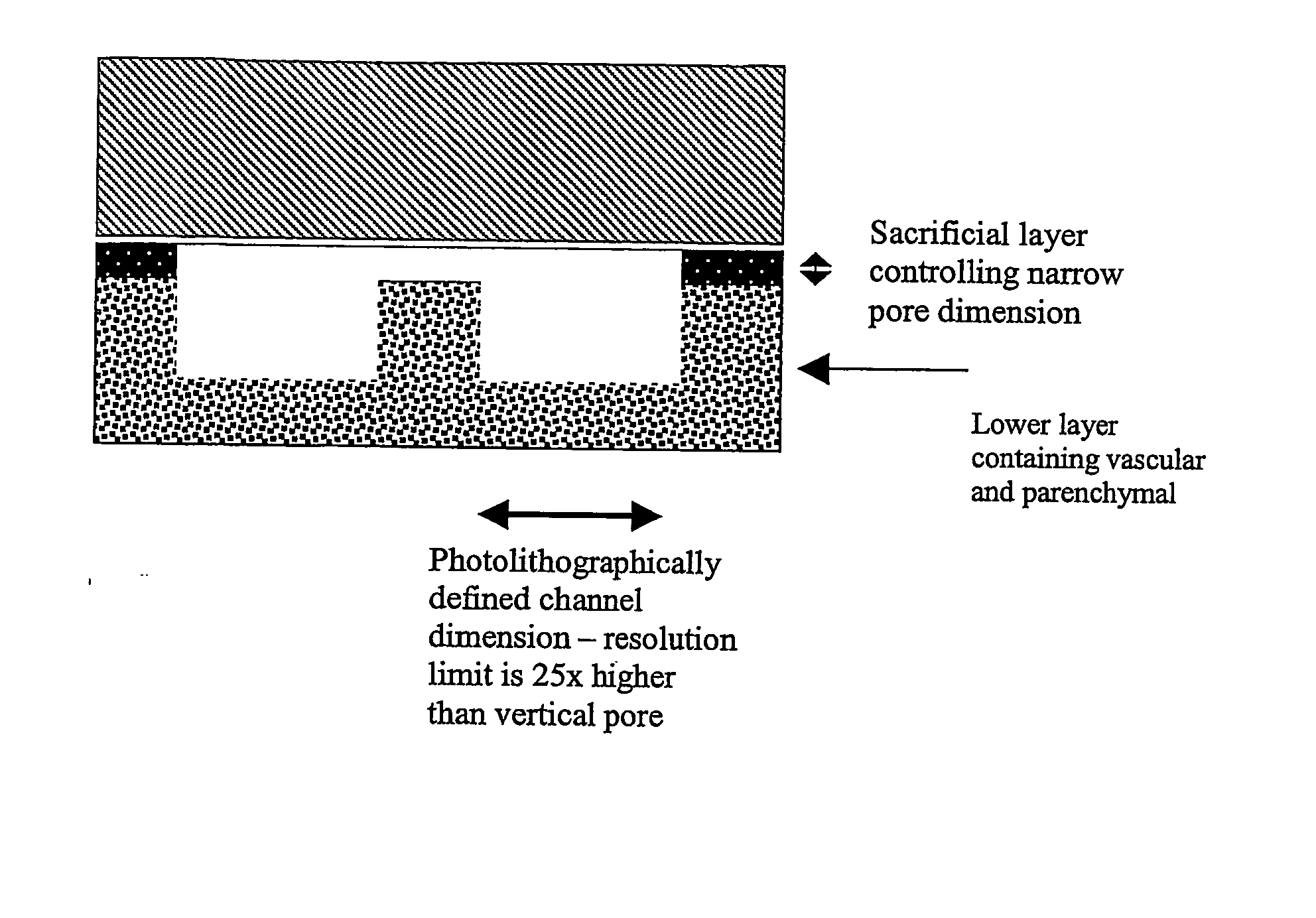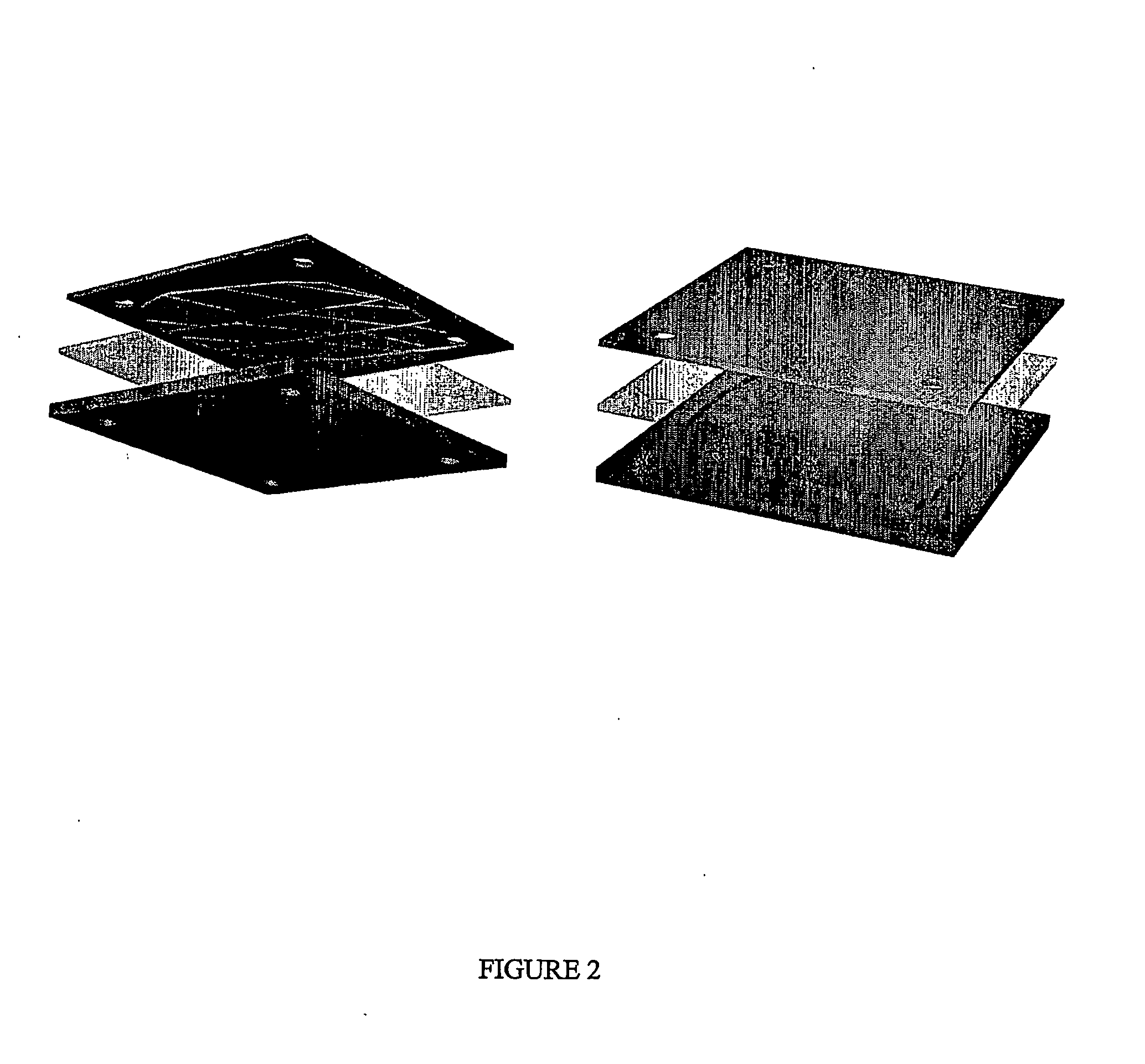Microfabricated Compositions and Processes for Engineering Tissues Containing Multiple Cell Types
a technology of multiple cell types and compositions, applied in the field of three-dimensional tissue engineered systems, can solve the problems of integrating these devices and tissues within the host, engendering processes, inflammation and clotting, etc., and achieves the effect of reducing the total volume of polymer and reducing the complexity of device fabrication
- Summary
- Abstract
- Description
- Claims
- Application Information
AI Technical Summary
Benefits of technology
Problems solved by technology
Method used
Image
Examples
example 1
Fabrication of Silicon and Poly(Dimethylsiloxane) Molds
[0126] Photolithography is the first step in micromachining silicon to define the nanoscale features that comprise the base layer. In this first step, a photosensitive surface (photoresist) was etched through the use of light. The photoresist was selectively exposed using a designed template and then the exposed areas were chemically removed in a developer. For this process, approximately 10 ml of Shipley's 1822 photoresist was used. The photoresist was spun onto the silicon wafer at 5000 rpm, resulting in a resin thickness of approximately 2 μm. The areas to be etched away were exposed in a Karl-Suss mask aligner. After exposure and development, the portions of the silicon that were to be etched into the vascular bed were visible and the parts that were not etched were protected by the photoresist.
[0127] The prepared wafer was subsequently used to perform a deep reactive ion etch using a Surface Technology Systems (STS) ion e...
example 2
[0130] The cross-linked PDMS mold was used to press melted poly(lactide co-glycolide) (PLGA) into the desired layer structure. A PDMS mold with a test pattern called J-Pore was placed on a rigid metal plate and roughly 6 grams of Medisorb low IV PLGA 85:15 polymer pellets were spread across the entire surface of the mold (FIG. 15, 16). A top PDMS mold with an unpatterned surface was placed over the pellet-covered bottom mold, while another rigid metal plate was placed on top of the stack. The entire stack was then placed on a hotplate at a temperature exceeding the glass transition temperature (>55° C.). During heating, approximately 100-300 lbs of force was applied to the stack for 8 minutes. After 8 minutes of simultaneous heat and pressure, the stack was removed and the two rigid metal plates were removed. The PDMS stack was placed on a flat metal surface and a large metal weight was placed on top of the stack to press it during the cooling step. The s...
example 3
Connecting and Bonding the Device
[0131] The PLGA layer was placed design-side down on a piece of PDMS. A 16-gauge syringe needle was heated with a heat gun and poked through the inlets and outlets of the PLGA layer generating four through-holes in each layer. The PLGA layer was then placed on a piece of cardboard with holes punched out beneath the through-holes. About 2 inches of size 020 silastic tubing was poked through each through-hole such that about 1 centimeter protruded on the design side. The tubes were secured in place by applying a small amount of urethane around the circumference of the tube. Urethane was allowed at least 30 minutes to dry. Any urethane and tubing on the design side of the PLGA layer was trimmed off with a sharp square razor blade.
[0132] When brought into molecular contact at a temperature above their glass transition temperature, the macroscopic interface between the surfaces of two pieces of similar polymer gradually disappeared and the interface's m...
PUM
| Property | Measurement | Unit |
|---|---|---|
| diameter | aaaaa | aaaaa |
| diameter | aaaaa | aaaaa |
| temperatures | aaaaa | aaaaa |
Abstract
Description
Claims
Application Information
 Login to View More
Login to View More - R&D
- Intellectual Property
- Life Sciences
- Materials
- Tech Scout
- Unparalleled Data Quality
- Higher Quality Content
- 60% Fewer Hallucinations
Browse by: Latest US Patents, China's latest patents, Technical Efficacy Thesaurus, Application Domain, Technology Topic, Popular Technical Reports.
© 2025 PatSnap. All rights reserved.Legal|Privacy policy|Modern Slavery Act Transparency Statement|Sitemap|About US| Contact US: help@patsnap.com



